Chinese Steamed Egg with Minced Pork
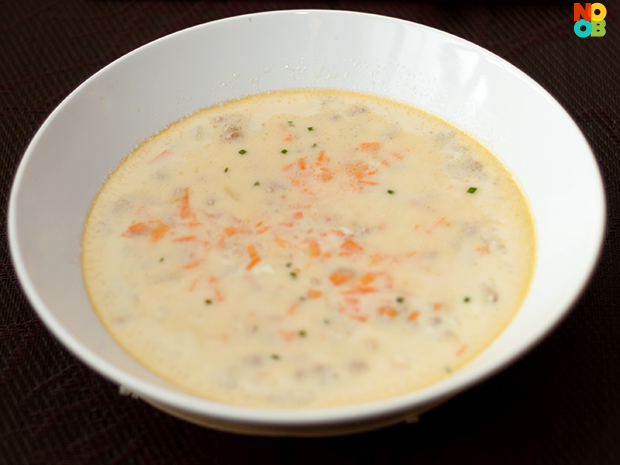

First posted in Jul 2009, updated in Jan 2015
Get this recipe on the next page >>
This Chinese-style steamed egg with minced pork (猪肉蒸蛋), also frequently known as Chinese steamed eggs or 蒸水蛋, is a family favourite dish. We love everyday dishes (家常菜) like this – unpretentious, comforting and so delicious with rice or porridge.
See Also:
- Steamed Three Eggs (Three Colour Egg) Recipe (above)
- Bittergourd with Salted Egg Recipe
- Easy Egg Recipes
Many readers have commented that the most challenging part of making steamed eggs is that the cooked egg mixture either look dry, or form unsightly bubbles on the surface. Check out the cooking tips below to get a smooth and silky finish for your steamed eggs.
Tips for making Chinese savoury steamed egg dishes
- Strain the egg mixture through a fine sieve 1-3 times to get a smooth texture.
- Use heat-safe (ceramic or oven) dish for steaming the egg custard. Plastic material will melt during steaming.
- Use a wide, shallow dish for steaming so that the egg and meat will be evenly distributed and cooked.
- If you happen to be cooking Chinese soups (clear soup such as ABC soup), you can use some of the soup as the base stock for the egg custard. You can also instant chicken stock or plain water (seasoned with soy sauce).
- When steaming the egg custard, make sure the dish is sealed with foil, so that water from the steamer cover will not fall on the custard during steaming and cause unsightly bubbles.
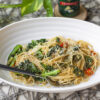
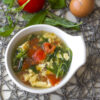
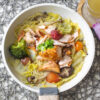
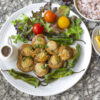
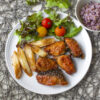
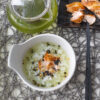
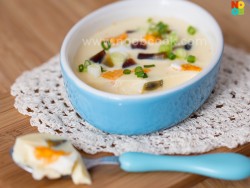
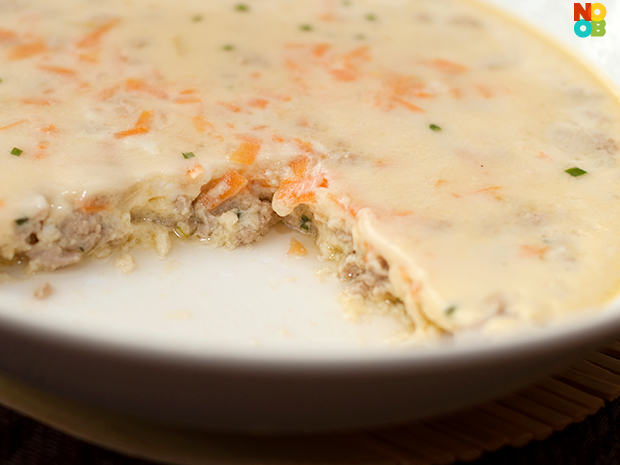



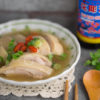

I eat this always when I was a kid, my fave but my mom does not use carrots, it adds some nice color to the steam egg. Yours looks so smooth, comforting. Wonderful!
carrots are not a usual addition, but like you said I thought it added some nice colours to the dish. Thanks for your kind words :)
Hi There,
First off apologies for contacting you through the comments but couldn’t spot an email address. I just wanted to bring your attention to http://www.foodandfizz.com which is a new photo sharing website. We love the photos here on your blog and would love to feature a couple of them on the site and hopefully send some traffic love back you way. Look forward to seeing them!
Regards
Ben
Hi,
I m a sotong at cooking so I just want to check for ingredients you indicate for example 3/4 cup is abt how many ml?
Hi Carol, you know the cup that comes with the rice cooker? It usually has some markings on it. 1 cup is 200ml so 3/4 cup is roughly 150ml.
is it common to be watery? i tried with 2 large eggs (4 egg yolks) in total and 3/4 cup of water…it turned out to be very watery.
Hi eggmaniac, I don’t think it’s supposed to be watery. Hmm u included the egg white ya? How about reducing the stock and see if that works for you. Also the cup I refer to is the Japanese cup measurement (1 cup =200ml) not the US cup measurement (1 cup =250ml).
thanks wiffy…will try that in the future..thnk u again.
Hi i love all your recipes and this website you created. It is so refreshing and friendly for a beginner cooker like me! Thanks for making cooking a tad more enjoyable and fuss free for everyone. You rock!
Thank you so much for your encouragement Debbie :)
Thank you for the recipe! I tried this today as I wanted something fast and simple yet tasty of course. And although i was confused about the cup measurement, ( I ended up using about 240 ml of stock) it was cooked beautifully. Even in a not so wide and not at all shallow tubberware popped in my multi-tiered steamer where i made the rice together =D
Next time I will use 200 ml as it should be! 谢谢!
Forgot to mentioned that i have in the past, tried to make this dish purely out of my imagination of how my grandma used to make it… ended up with minced pork floating above a mixture of water and eggs. Was really ugly and not at all like how I remember it.
You really have alot of receipes here that are my favourites from Singapore. I miss them terribly. Thank you once again for your very lovely recipes!
Hi Sara, thanks so much for your kind words of encouragement. I’m touched and glad the recipe came in handy.
Reminds me when I was a kid when mum used to make it
….. but could we not simply microwave dish with the advent of
electromagnetic energy…. and more steamed pork recipes please.
May I know why is there a need to stir fry the minced meat first? My mum taught me a version that is to add the minced meat directly to the egg mixture.
Hi, I do that because most of the time, the pork is still slightly reddish (undercooked) even though the egg mixture is already cooked. If you can ensure that the pork is cooked through, then you don’t have to stir-fry first. Another trick I tried before is to first steam the pork for a few minutes, drain the excess water collected, before pouring the egg mixture over.
Hi Wiffy, this is really a fav childhood dish! My mom does this without the pork but with salted egg yolk ..yummy too. I must try doing this one day…. Btw, in your step 3 iii), I think you mean “strained egg mixture” , not stained egg mixture :-) wink wink :-)
Happy New Year!
This is actually a very, very simple–but surprisingly flavorful–dish that is very easy prepare. Preparation before steaming shouldn’t take more than a few minutes. Suggestion for you: don’t make your recipe appear so complicated (e.g. don’t say “strain with sieve” (do you really think Chinese people back on the farm do this?” or To minimize bubbles, do not beat the eggs but gently stir the eggs with a pair of chopsticks using a cutting action.”; just leave it at beat eggs–otherwise, people get turned off by a seemingly complicated recipe–that really is truly easy to do! Second suggestion: add minced scallions to egg mixture.